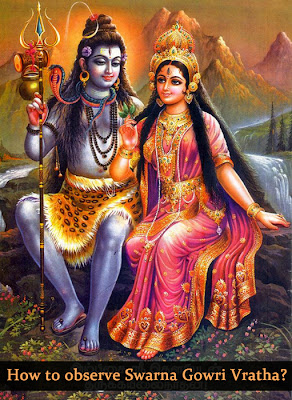Gowri Habba or Swarna Gowri Vratha is dedicated to Goddess Paravati, also known as Gowri. The ‘Vratha’ is mainly observed by married and unmarried women and is mainly performed in Karnataka and other places in South India. An answer to How to do the Gowri Habba or Swarna Gowri Vratha is bit complex as there are numerous regional and community variations in performing the ritual. The festival is also known as Ganesha Gowri or Ganesh Habba as Ganesh Chaturthi falls on the next day.
Performing Gowri Habba
On the Swarna Gowri Vratam day, the house is cleaned thoroughly. After bathing married women and young girls in the family dress up neatly. Some people perform the puja at home; others at the houses of relatives or friends and some opt for the nearby temples.
A small temporary shrine is erected using banana leaves and banana stem. This is decorated with mango leaves, turmeric, tulsi and sandalwood paste. Those who already have a puja cabinet perform the ritual in it or in a separate temporary area.
Next is the installation of the idol of Goddess Parvati or Gowri. There are several methods for this. The indigenous method is to make an idol of Gowri with turmeric. Nowadays, people opt for the ready made idols of Goddess Gowri which is available in market. Some people opt for the family owned Swarna or gold idol of Gowri.
The idol of Gowri, which is decorated neatly with clothes, is placed on a bed of rice or wheat or other cereals. Some people place a Shiva linga and Ganesha idol along with the idol of Parvati. Flowers and green leaves are mainly used to decorate the idols. Some people also opt for a Purna Kumbh. A mirror is placed along with the idol.
A 16-knotted thread is prepared for the puja and some people tie it on their hands. (Perhaps indicating the 16 long years of intense austerities performed by Goddess Parvati to obtain Lord Shiva as husband).
Morada Baagina
Next is the preparation of special puja plates or thalas with various puja items also known as ‘Gowri Morada bagina.’ The pooja thala or plate consists of turmeric, kum kum, a mirror, bangles, comb, various cereals, coconut, fresh cloth, rice, jaggery, the 16 knot thread, 16 different leaves and fruits. Some people prepare just one pooja thala for Goddess Parvati. Some prepare several ‘bagina’ and distribute among married women. (Please note that the number of items and those used varies from region to region.)
The main puja ceremony involves bathing the idol in milk, ghee, curd, honey and water. Some people only perform the simple Aarti and sing bhajans.
After the pooja, women exchange decorated bamboo plates (mora) filled with nine types of grain (navadhanya), along with Jaggery, bangles, turmeric, a blouse piece, kumkum, betel leaves, fruits and nuts and dakshina/money. This is known as Morada Bagina. Women perform the pooja at their maternal homes as a mark of respect and gratitude to their parents.
Then the prepared bagina is offered to Gowri and people recite the prayers dedicated to Parvati or the special phrases used during the occasion like ‘Savitri, Savitri, Bagina Togo.’ While taking away the bagina repeat the same prayers or say ‘muthaiyde, muthaiyde bagina kodu.’
Gowri Habba Feast
Delicious food is prepared on this day and offered to the goddess. Dishes like Chitranna (colored rice), Payasa (pudding), Kayi Holige (a sweet bread stuffed with coconut mixture), Tovve, Saru /RasamKayi Kadabu, Palya (Vegetable dish), Kosambari (salad) and Ambode or bhajj are prepared and relished together by everyone at home.
Another important custom on the day is the sending of gifts by married women’s parents. Newly married girls also present ‘bagina’ to married elderly women.
It is believed that by performing this puja unmarried girls will get good husbands and married women will have a healthy and peaceful family life.
Visarjana
The next day, Gowri is given a warm visarjana/ send off by offering Udi (offering all the sacred items like Turmeric, Flowers, Vermilion, Blouse piece, Rice, Betel nuts and leaf, Turmeric root and dry Coconut) and the clay idol is immersed in water along with Lord Ganesha’s idol. In some areas, people immerse the Turmeric idol along with Ganesha. (Gowri Habba is followed by Ganesh Chaturthi).
Gowri habbada mangaladravya
Another specialty of this festival is that the 'tavaru maneyavaru' (the married woman's parents and brothers) send gowri habbada mangaladravya to the married women of their family. Some send money as a substitute for mangaladravya. This good practice remains unchanged and keeps people closer. Newly married women give 16 jothe baagina to sumangalis (married women) and obtain their blessings. One baagina is kept for Gowramma.
It must be remembered here that all these rituals are man made. It is easy to observe these rituals when you live along with relatives and friends. Today, most people live alone that too in countries alien to such rituals. A simple prayer to Goddess Parvati will be more than enough. Always remember the core concept of Santana Dharma is Brahman – the supreme soul present in all living and non-living - and realization of it is the ultimate aim.







